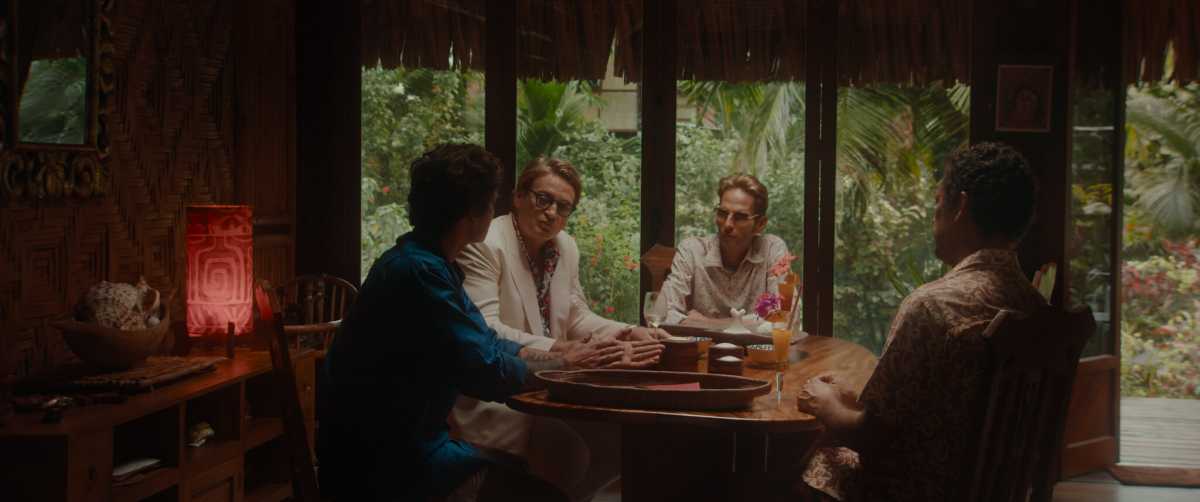Rather than telling the plot of gay Spanish director Albert Serra’s “Pacifiction,” it would do more good to lay out some of its images. Its protagonist, de Roller (Benoit Magimel), struts around the island of Tahiti, where he’s the French government’s high commissioner, in a uniform of lightly tinted sunglasses, white linen suit and flowered shirt, day after day. Ships full of surfers ride impossibly high waves, lifted at angles so extreme that the risk of drowning looks inevitable. A topless female DJ becomes mesmerized by the dark ambient music, full of crackling distortion, she plays at a nightclub. In the same space, an elderly admiral (Mark Susini) dances flirtatiously with several men under blue light to quiet, dubby electronic music. De Roller stands in an empty football field at night, welcoming a drenching rain with his head titled slightly back. It might be easier to say what “Pacifiction” is about — French colonialism, the threat of nuclear radiation — than what it is, but the former is transformed by the latter. After seeing “Pacifiction” twice, I feel like I’ve barely scratched the surface.
De Roller believes himself to be in command of the story, such as it is. Magimel’s performance oozes a smugness that comes with power. His job requires him to interact with the public all day, and he’s less adept at it than he believes himself to be. Meeting with a community group, he makes a case that a new casino, intended to attract tourists, should be open to Tahitian residents as well, despite their objections. Slowly but surely, the island is becoming less isolated. Throughout the film, the dialogue drops references to the French possibly launching secret tests of nuclear weaponry in the nearby sea for the first time in 20 years. He hangs out with a trans woman, Shannah (Pahoa Mahaganafanu), and becomes her lover. As the rumors of nuclear tests become impossible to tune out, De Roller comes to realize that he’s hardly the most powerful Frenchman in the area.
Serra’s pacing is unusual. Tahiti seems rather dull, as there’s nothing to do at night but kill time getting drunk and trying to pick someone up at its sole nightclub. De Roller and other Frenchmen spend most of their free time there. The film’s elements of queerness have a colonial tinge, as white Frenchmen get to exercise their desires with ordinary Tahitians. Often, it’s a hang-out movie, willing to pass along the experience of getting antsy watching other people dance and drink. The surf scene suddenly springs it to life with an amazing burst of energy, and the film’s power accumulates from there, leading to a final hour that left my jaw on the floor. Having had the same reaction to it twice, its longueurs are clearly intentional, but its style is designed to suck the viewer in further and further.
An ordinary film would set De Roller on a redemption arc, flirting with turning him into a white savior of the Tahitians. De Roller never does find his moral compass, nor does he care about anyone besides himself. His worries about nuclear testing mostly concern his own safety. His behavior shows sprinkles off a halfhearted embrace of death.
By Serra’s standards, this is a move towards a bigger audience. Within France, Magimel is a major star. Serra has one foot in the art world and another in cinema, and his previous work has sometimes felt like a conceptual endeavor. He followed his 2016 “The Death of Louis XIV,” in which now-elderly French New Wave icon Jean-Pierre Léaud portrayed the 18th-century king, with a non-narrative riff on the same material, “Roi Solleil.” But “Pacifiction” offers reference points, from French painter Paul Gauguin to writers like Joseph Conrad and Graham Greene, which aren’t hard to pinpoint. It was inspired by the memoir of Marlon Brando’s Tahitian ex-wife Tahita Teriipaia.
The final hour of “Pacifiction” descends into a different world than the one the film initially inhabits. As de Roller roams through a dark, nocturnal Tahiti, Serra and cinematographer Artur Tort flood the set with deep, blinding red and blue lights. The colors grow unnaturally distorted. While the final scene offers some narrative satisfaction, the moments coming just before it race from ellipsis to ellipsis and blur out life outside the nightclub. It’s a film you live alongside for 165 minutes, best seen on the biggest screen possible, rather than something to passively observe on a TV. Serra finds the exercise of power tremendously uncanny, ending with a sick feeling that the blown-out sights and sounds surrounding de Roller are merely an elaborate death rattle. So often, writing about a film as though it were nothing but the sum total of its themes betrays the far more complicated and immediate experience of watching it. More than any film I’ve seen in years, “Pacifiction” yearns for something impossible to sum up in words, and it arrives there.
“Pacifiction” | Directed by Albert Serra | Grasshopper Film/Gratitude Films | Opens Feb. 17th at Film at Lincoln Center



































